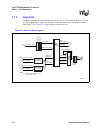
242 Hardware Reference Manual
Intel
®
IXP2800 Network Processor
Media and Switch Fabric Interface
The use of some of the receive and transmit pins is based on protocol, SPI-4 or CSIX. For the
LVDS pins, only the active high name is given (for LVDS, there are two pins per signal). The
definitions of the pins can be found in the SPI-4 and CSIX specs, referenced below.
An alternate system configuration is shown in the block diagram in Figure 89. In this case, a single
IXP2800 Network Processor is used for both Ingress and Egress. The bit-rate supported would be
less than in Figure 88. A hypothetical Bus Converter chip, external to the IXP2800 Network
Processor, is used. The block diagram in Figure 89 is only an illustrative example.
Figure 88. Example System Block Diagram
A9759-01
Ingress
Intel
®
IXP2800
Network Processor
Framing/MAC
Device
(PHY)
SPI-4
Protocol
RDAT
Receive protocol is SPI-4
Transmit mode is CSIX
TDAT
Egress
Intel IXP2800
Network Processor
TSTAT
Flow Control
Receive protocol is CSIX
Transmit mode is SPI-4
RDAT
Optional
Gasket
(Note
1
)
Switch
Fabric
CSIX
Protocol
RSTAT
TDAT
Notes:
1. Gasket is used to convert 16-bit, dual-data Intel IXP2800 Network Processor signals to wider
single edge CWord signals used by Switch Fabric, if required.
2. Per the CSIX specification, the terms "egress" and ingress" are with respect to the Switch Fabric.
So the egress processor handles traffic received from the Switch Fabric and the ingress
processor handles traffic sent to the Switch Fabric.


















